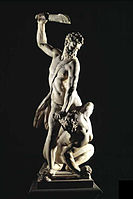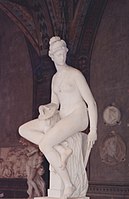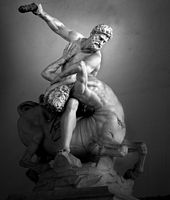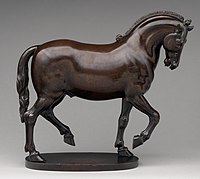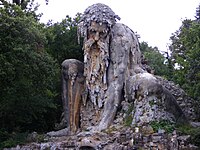Giambologna
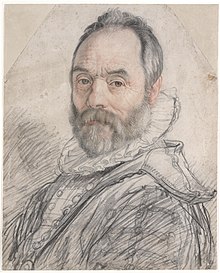
Giambologna (1529
Biography
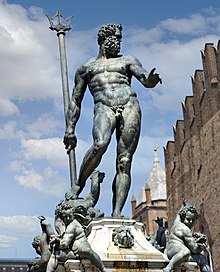
Giambologna was born in Douai, Flanders (then in the Habsburg Netherlands and now in France), in 1529. After youthful studies in Antwerp with the architect-sculptor Jacques du Broeucq,[2] he moved to Italy in 1550 and studied in Rome, making a detailed study of the sculpture of classical antiquity. He was also much influenced by Michelangelo, but developed his own Mannerist style, with perhaps less emphasis on emotion and more emphasis on refined surfaces, cool elegance, and beauty. Pope Pius IV gave Giambologna his first major commission, the colossal bronze Neptune and subsidiary figures for the Fountain of Neptune (the base designed by Tommaso Laureti, 1566) in Bologna.
Giambologna spent his most productive years in
Work
Giambologna became well known for a fine sense of action and movement, and a refined, differentiated surface finish.
Among his celebrated works are the Mercury (of which he did four versions), poised on one foot, supported by a zephyr. The god raises one arm to point heavenwards in a gesture borrowed from the repertory of classical rhetoric[a] that is characteristic of Giambologna's style.

In his Abduction of a Sabine Woman (1574–82),
Giambologna's several depictions of Venus established a canon of proportions for the female figure,[citation needed][original research?] and set reference models for representation of the goddess that were influential for two generations of sculptors in Italy and Northern Europe.[citation needed]
He created allegories strongly promoting Medicean political propaganda, such as
On Michelangelo's death in 1564, Daniele da Volterra created several busts of the sculptor from his death mask. After Volterra died in 1566, one of these busts was delivered to Giambologna, who around 1570 sculpted a clothed upper torso for the bust.[7]
The equestrian statue of Cosimo I de' Medici, also in Florence, was completed by his studio assistant Pietro Tacca.
Giambologna provided as well as many sculptures for garden grottos and fountains in the Boboli Gardens of Florence and at the Villa di Pratolino, and the bronze doors of Pisa Cathedral. He created the bronze sea-horses and some other sculptures for Bartolomeo Ammannati's Fountain of Neptune, Florence.[8]
For the grotto of the Villa di Castello he sculpted a series of studies of individual animals, from life, which may now be viewed at the Bargello. Small bronze reductions of many of his sculptures were prized by connoisseurs at the time and ever since, for Giambologna's reputation has never suffered eclipse.
Giambologna was an important influence on later sculptors through his pupils Adriaen de Vries and Pietro Francavilla who left his atelier for Paris in 1601, as well as Pierre Puget who spread Giambologna's influence throughout Northern Europe, and in Italy on Pietro Tacca, who assumed Giambologna's workshop in Florence, and in Rome on Gian Lorenzo Bernini and Alessandro Algardi.
Gallery
-
V&A MuseumLondon
-
Architettura, Bargello, 1565, Florence. This sculpture exemplifies the long limbs of Giambologna's influential ideal female type.
-
Female Figure, 1571–73, J. Paul Getty Museum, Los Angeles
-
V&A Museum, London)
-
Bathing Venus, 1573, Buontalenti Grotto, Boboli Gardens, Florence
-
Horse by Giambologna (workshop), probably around 1590. 10 inches (25 cm) high.
Notes
References
- ^ His birth is placed as early as c. 1524; see Lawrence Gowing, ed., Biographical Encyclopedia of Artists, v.2 (Facts on File, 2005): 257.
- ^ R. Wellens, Jacques du Broeucq, sculpteur et architecte de la renaissance (Brussels) 1962
- ^ ISBN 9780714829531.
- ISBN 0918825393.
- ^ "Samson Slaying a Philistine". Retrieved 2022-08-09.
- ^ "History of the fountain". Archived from the original on 2008-04-11. Retrieved 2007-03-16.
- ^ "Casa Buonarroti". Piccoli Grandi Musei (in Italian). Retrieved 21 August 2019.
- ^ Horner, Susan; Horner, Joanna B. (1884). Walks in Florence and Its Environs. Smith. p. 199.
FOUNTAIN OF NEPTUNE florence bronze sea-horses by Giovanni da Bologna.
Further reading
- A. Rudigier, B. Truyols: Giambologna. Court Sculptor to Ferdinando I. His art, his style and the Medici gifts to Henri IV, London, 2019, ISBN 978-1-912168-14-9.
- Gloria Fossi, et al., Italian Art, Florence, Giunti Gruppo Editoriale, 2000, ISBN 978-1-912168-14-9.
- Giambologna, 1529–1608: sculptor to the Medici: an exhibition organised by the Arts Council of Great Britain etc., catalogue edited by Charles Avery and Anthony Radcliffe. London, Arts Council of Great Britain, 1978, ISBN 0-7287-0180-4.
External links
- Biography with a portrait on kfki.hu
- Giambologna on mega.it
- "Model of a River God". Sculpture. Victoria and Albert Museum. Retrieved 2007-09-22.
- "Samson and a Philistine". Sculpture. Victoria and Albert Museum. Archived from the original on 2009-07-09. Retrieved 2011-03-15.
- "The Flagellation of Christ". Red Wax Sculpture. Queensland Art Gallery. Archived from the original on 2011-03-12. Retrieved 2011-03-15.
- "Rape of Proserpina". Bronze. Norton Simon Museum. Retrieved 2015-02-20.
- A Tour of the location of Giambologna's major works in Florence

